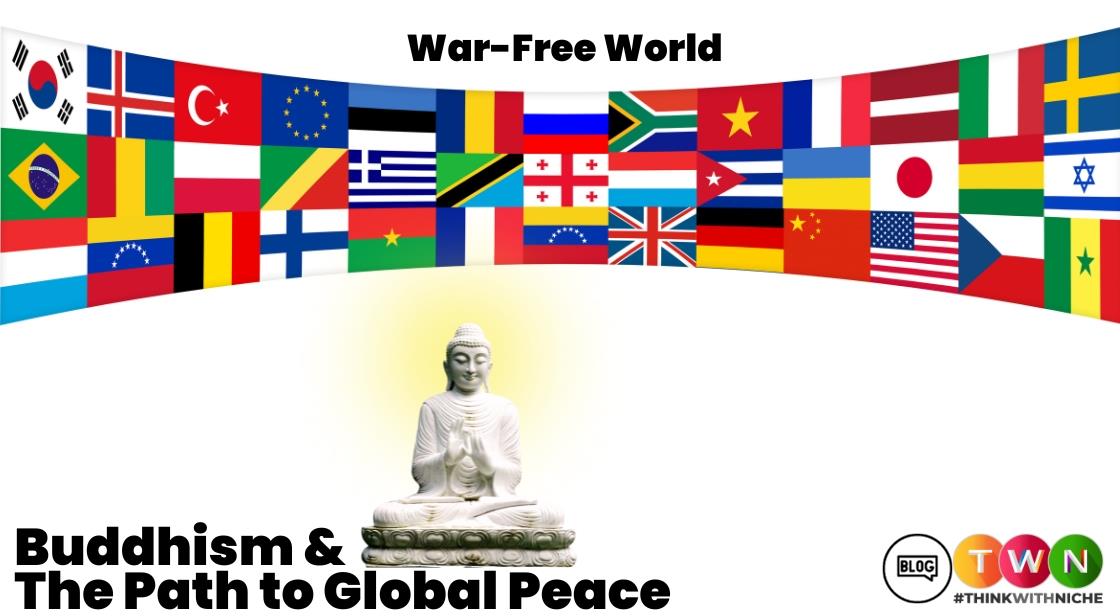Buddhism and the Path to Global Peace: A War-Free World

Blog Post
Throughout the annals of human history, the world has been marred by countless wars and the rise and fall of civilizations. The toll exacted by wars and violent conflicts surpasses the casualties caused by natural disasters or diseases.
From the ancient epochs to the contemporary era, the reasons behind wars may vary, but the outcomes remain hauntingly horrific. One cannot help but question the gains, if any, from these tumultuous episodes.
Today, our global landscape is precarious, perched on the edge of a potential catastrophe. An arms race among nations fuels the creation of increasingly perilous and lethal weapons.
Resources that could be channeled toward the welfare of citizens are diverted to the production of instruments of destruction and devastation.
Shockingly, in some parts of the world, citizens grapple with hunger, while a significant portion of the budget is allocated to missiles and ammunition.
The world has recently borne witness to the grotesque manifestations of conflict in events such as the Russia-Ukraine War and the violent clashes between Israel and Hamas. These incidents, staining humanity's conscience, underscore the urgent need for a collective awakening.
As we stand on this precipice, uncertain of our future, one must ponder: Can this relentless march towards self-destruction be halted? Is there a force that will intervene before humanity ignites its own funeral pyre? Could a savior emerge to rescue us?
While violence and war scar the canvas of our world, there exist counteracting forces and ideas that champion peace and harmony, steering the world towards a righteous path. The eternal dance between destructive and creative forces maintains the delicate equilibrium of human civilization.
It is said that while a person may perish, thoughts are immortal and indestructible. One such enduring philosophy emerged from the windswept lands of India—the teachings of Mahatma Buddha.
Rooted in the fundamental principles of love, truth, and non-violence, Buddha's philosophy seeks to establish peace in the world, grounded in the well-being of humanity.
In our current tumultuous times, where hope seems elusive, the philosophy of Mahatma Buddha emerges as a guiding beacon through the darkness.
As we delve into this article, we shall explore how the profound teachings of Buddha can impart valuable lessons of peace to the entire world, reminding humanity of its fundamental purpose in the grand tapestry of life.
In today's world, marked by conflict and violence, Buddhism offers a unique and powerful path to global peace. Its teachings, based on the insights of the Buddha, provide a framework for understanding the causes of suffering and conflict, and for cultivating the qualities of compassion, wisdom, and non-violence that are necessary for creating a more peaceful world.
The Buddha conveyed that the fundamental source of suffering lies in attachments and cravings. When we cling to things, people, or ideas, we are constantly afraid of losing them, which leads to anxiety, stress, and conflict. Buddhism teaches us to let go of our attachments and to live in the present moment with mindfulness and compassion.
Another important Buddhist teaching is the concept of interdependence. This means that we are all interconnected and that our actions have consequences for others. When we harm others, we are ultimately harming ourselves. Buddhism teaches us to develop a sense of universal responsibility and to act in ways that benefit all beings.
Introduction to Mahatma Buddha: Birth and Early Life
Mahatma Buddha, also known as Siddhartha Gautama, was a spiritual leader and the founder of Buddhism, a profound philosophy that has left an indelible mark on the world. Born in the 6th century BCE in Lumbini, a region that is now part of Nepal, his life's journey would unfold as a quest for enlightenment and a path to alleviate human suffering.
Birth of Mahatma Buddha in Lumbini:
Siddhartha Gautama's birth is shrouded in legend and significance. According to Buddhist tradition, Queen Mahamaya, his mother, gave birth to him in the tranquil gardens of Lumbini under a sal tree. The event is said to have occurred during the full moon in the month of Vesak, which usually falls in April or May. The newborn Siddhartha, it is believed, took seven steps, and with each step, a lotus flower blossomed under his feet.
Royal Heritage and Early Life:
Siddhartha was born into the Sakya clan, a ruling family in the kingdom of Kapilavastu. His father, King Suddhodana, shielded him from the harsh realities of life, ensuring that Siddhartha lived a life of luxury and opulence within the palace walls. The king, upon Siddhartha's birth, consulted a sage who predicted that the young prince would either become a great king or a great sage.
Kept within the palace confines, Siddhartha was shielded from the suffering and hardship prevalent beyond the royal walls. His early years were marked by indulgence and extravagance, but as he grew older, a sense of curiosity about the world outside the palace began to stir within him.
The Four Encounters:
Despite the efforts to shield him, Siddhartha's encounters with the realities of life were inevitable. It is said that on four separate occasions, he witnessed an old person, a sick person, a corpse, and finally, a wandering ascetic. These encounters left a profound impact on him, stirring a deep contemplation about the nature of existence, suffering, and the pursuit of meaning.
The Great Renunciation:
In his late twenties, Siddhartha made a momentous decision. Driven by a quest for truth and a desire to understand the causes of human suffering, he renounced his princely life. This event, known as the Great Renunciation, involved leaving behind his royal status, wife, and infant son, Rahula, to embark on a spiritual journey as an ascetic.
Thus began the transformative journey of Siddhartha Gautama, who would ultimately become Mahatma Buddha, the enlightened one, and impart the teachings that form the foundation of Buddhism.
Buddha and Emperor Ashoka: Connecting Lives and Legacies
The connection between Buddha and Emperor Ashoka is a profound historical and spiritual linkage that spans generations. It's a story of spiritual transformation, political evolution, and the enduring impact of Buddhist principles. Let's delve into the lives of Buddha and Emperor Ashoka to understand this unique connection.
Buddha's Influence on Ashoka
The Enlightenment of Buddha:
Siddhartha Gautama, later known as Buddha, attained enlightenment under the Bodhi tree in Bodh Gaya. His teachings revolved around the Four Noble Truths and the Eightfold Path, emphasizing the path to the cessation of suffering (Nirvana). Buddha's profound insights into the nature of existence and human suffering laid the foundation for Buddhism.
Ashoka's Early Life
Emperor Ashoka, who ruled the Indian subcontinent from 268 to 232 BCE, was initially not associated with Buddhism. He was the grandson of Chandragupta Maurya and son of Emperor Bindusara. Known for his military conquests and expansion of the Mauryan Empire, Ashoka's early reign was marked by bloodshed and warfare.
The Kalinga War : A Turning Point
The pivotal moment in Ashoka's life occurred during the Kalinga War, where a vast number of lives were lost, and the brutality of the conflict deeply affected him. Witnessing the aftermath of the war, Ashoka experienced a profound transformation. Stricken with remorse and guilt, he turned away from violence and sought a more compassionate and righteous path.
Also Read : Mahatma Gandhi A Great Teacher Who Taught The Ways To Live
Ashoka's Conversion to Buddhism:
Adoption of Buddhist Principles: In the quest for redemption, Ashoka turned to Buddhism. He embraced the teachings of Buddha and incorporated them into his governance. Ashoka's conversion to Buddhism marked a monumental shift in his policies, focusing on non-violence, religious tolerance, and the well-being of his subjects.
Edicts of Ashoka: Emperor Ashoka inscribed his newfound principles on stone pillars and rocks, known as the Edicts of Ashoka. These edicts, composed in various regions of the empire, conveyed messages of tolerance, moral conduct, and social welfare. They stand as historical evidence of the first time a ruler promoted the principles of non-violence and compassion.
Spread of Buddhism: One of Ashoka's most significant contributions was the spread of Buddhism beyond the Indian subcontinent. He sent emissaries to various parts of the world to propagate Buddhist teachings. His efforts led to the establishment of Buddhist communities in places like Sri Lanka and Central Asia.
Legacy:
Impact on Buddhism: Emperor Ashoka's patronage played a pivotal role in the expansion and institutionalization of Buddhism. Monasteries, stupas, and relics associated with Buddha were constructed under his sponsorship.
Enduring Influence: The connection between Buddha and Emperor Ashoka illustrates the transformative power of spiritual realization on governance. Ashoka's commitment to Buddhist principles left an enduring legacy, shaping the moral and ethical framework of his empire.
In essence, the lives of Buddha and Emperor Ashoka are intertwined through the common thread of Buddhism, a connection that resonates through history as an example of the profound impact of spiritual wisdom on worldly affairs.
Buddhism and the Path to Global Peace: A War-Free World
Buddhism's Enduring Message of Peace:
Buddhism is a religion that has long been associated with peace and non-violence. In today's world, which is plagued by conflict and violence, Buddhism offers a unique and powerful path to global peace.
The Buddhist Vision of Peace
The Buddhist vision of peace is based on the understanding that all beings are interconnected and that suffering is caused by attachment and craving. When we let go of our attachments and live in the present moment with mindfulness and compassion, we create the conditions for peace.
The Causes of Violence
Buddhism teaches that the root cause of violence is ignorance. When we do not understand ourselves or others, we are more likely to resort to violence. Other causes of violence include attachment, anger, and hatred.
Preventing Violence
Buddhism teaches us to prevent violence by cultivating compassion, wisdom, and non-violence. When we develop these qualities, we are less likely to engage in conflict and violence.
Realizing Peace
Peace is not simply the absence of conflict. It is a positive state of being that is characterized by compassion, wisdom, and harmony. To realize peace, we must cultivate these qualities within ourselves and in the world around us.
Buddhism and Peacemaking
Buddhism has a long history of peacemaking and conflict resolution. Buddhist principles have been used to resolve conflicts in many parts of the world, including India, Sri Lanka, and Cambodia.
Promoting a Culture of Peace
Buddhism can promote a culture of peace by teaching us to live in harmony with ourselves, others, and nature. Buddhist values such as compassion, wisdom, and non-violence are essential for building a peaceful world.
In addition to the above, I would like to add that Buddhism is a practical religion. It is not just a set of beliefs or philosophies. It is a way of life that teaches us how to live in peace and harmony with ourselves, others, and the world around us.
If we want to create a more peaceful world, we need to start by cultivating peace within ourselves. This means developing compassion, wisdom, and non-violence. We also need to teach these values to our children and to the next generation.
Buddhism can help us to create a more peaceful world by providing us with a framework for understanding the causes of conflict and the qualities that are necessary for peace. It can also teach us how to live in peace and harmony with ourselves, others, and nature.
Saddharmapundarika Sutra: Unveiling the Lotus of True Peace
The Lotus Unveiled: A Beacon of Buddhist Peace
The Saddharmapundarika Sutra, also known as the Lotus of the True Law, intricately weaves the Buddhist ideal of peace. Esteemed as one of Mahayana Buddhism's cornerstones, this scripture unfolds the doctrine of the One Vehicle and the concept of the eternal Buddha.
The Ethical Path of the Boddhisattva
At its core, the Lotus teaches an ethical path synonymous with the life of a Boddhisattva—a journey of creative altruism culminating in ultimate peace. Through its myriad teachings, the Lotus embodies an ideology that extends beyond personal tranquility, laying the foundation for a world at peace.
Universal Responsibility: A Pillar for World Peace
The Lotus Sutra advocates for universal responsibility, emphasizing equitable distribution of natural resources and a genuine concern for future generations. It proposes a vision where the world unites as a pure and peaceful land, fostering a collective commitment to global well-being.
Inclusivity of the Lotus: Everything Will Be Saved
The boundless scope of the Lotus Sutra is awe-inspiring. In its teachings, nothing is excluded—from the minutiae of individual existence to the vastness of society, encompassing mountains, rivers, trees, birds, fish, animals, and seeds. The Lotus promises salvation for all.
Devadatta's Tale: Lessons in Violence and Non-Violence
Chapter XII of the Lotus narrates the tale of Devadatta, a disciple and cousin of Buddha who strayed from the path, indulging in heinous crimes. Contrasting the evil deeds of Devadatta with Buddha's enduring compassion, the story becomes a lesson in both violence and non-violence, revealing the power of the latter.
Purifying the Buddha Land: A Societal Transformation
The essence of the Lotus extends beyond individual salvation. It envisions the purification of the Buddha land, symbolizing a transformation of the entire society. Chapter XI emphasizes wrestling with the actuality of life and working towards societal purification for genuine happiness.
Facing Suffering: A Call to Positive Engagement
Chapter "Beholding the precious stupa" urges individuals not to evade reality but actively engage with it. It underscores the importance of directly addressing the sufferings of ordinary people, emphasizing that idealism alone is insufficient to serve others; one must grapple with real-world issues.
Divine Power and World Federation
Chapter XXI, "The divine power of the Tathagata," showcases Buddha's revelation of divine power and mystical phenomena. The concept of "One Buddhaland" symbolizes the formation of a world-federation, urging followers to translate this vision into proactive efforts for a harmonious world.
In essence, the Lotus Sutra, with its profound teachings on peace, transcends the individual, offering a blueprint for societal transformation and global unity.
Unveiling the Buddhist Concept of Peace
The Buddhist worldview offers profound insights into the essence of peace, grounded in the principles of interconnectedness and dependent origination. At the heart of Buddhist philosophy lies the belief that the universe operates according to eternal laws, with the concept of karma or dependent origination serving as a fundamental pillar.
Dependent Origination: The Cosmic Tapestry:
Laws of the Universe: Buddhists believe that the Buddha, having awakened to the laws of the universe, revealed the perpetual nature of these laws. Dependent origination, a cornerstone of Buddhist thought, elucidates that every element, sentient or insentient, exists in relation to everything else.
Interconnected Existence:
-
At the micro level, the human being is also seen as a string of processes governed by the principle of dependent origination. This means that nothing within a human being is genuinely independent.
-
The Buddhist doctrine of no-self (anatta) teaches us that there is no permanent, unchanging self. This does not mean that we do not exist, but rather that our existence is dependent on other things.
-
The Buddhist view of peace is based on the understanding of interconnectedness and the doctrine of no-self. When we understand that we are all interconnected and that there is no permanent, unchanging self, we are less likely to engage in conflict and violence.
-
According to this doctrine, nothing stands alone; everything is interdependent. Causes and conditions weave an intricate web of existence where the cessation of contributing factors leads to the cessation of existence. This interconnectedness extends to all entities, forming a colossal, interwoven compound of existence.
Indra's Net: The Cosmic Network:
-
Macrocosmic Harmony: The Buddhist perspective envisions the universe as "Indra's Net," a network of jewels representing an interconnected web of nodes. Each node reflects the entirety of the web, creating a harmonious interplay where changes in one node reverberate across the entire cosmic tapestry.
-
Endless Interrelatedness: At both macro and micro levels, the Buddhist worldview emphasizes the endless interrelatedness of all phenomena. Even in the vast cosmos, where countless universes exist, every element remains connected in ways that extend beyond our immediate perception.
Human Existence: A Symphony of Processes:
-
Dependent Origination at the Microcosmic Level: Applied to the human being, dependent origination views life as a series of interdependent processes. Every aspect of a person, from physicality to thoughts, relies on other elements for existence. The doctrine of no-self (anatta) underscores the absence of genuine independence within the human experience.
-
Unity in Diversity: While emphasizing the interconnected nature of all beings, Buddhism acknowledges the diversity and uniqueness of each individual. Constant change and adaptation mark the journey of every being, responding to stimuli in distinct ways yet unified by the shared thread of interdependence.
Buddhism and Global Peace:
The Buddhist teachings on peace and non-violence have been a source of inspiration for many peace movements and activists around the world. For example, the Dalai Lama has been a vocal advocate for peace and non-violent conflict resolution.
The Buddhist concept of ahimsa has also been influential in the Indian independence movement and the civil rights movement in the United States.
In recent years, there has been a growing interest in the application of Buddhist principles to global peacebuilding. For example, the World Buddhist Forum was established in 2006 as a platform for Buddhists from around the world to work together to promote peace and understanding. The Forum has organized a number of conferences and events to address global issues such as climate change, poverty, and conflict.
How Buddhism Can Help Us Create a War-Free World:
Buddhism can help us create a war-free world by teaching us to cultivate the qualities of compassion, wisdom, and non-violence. When we develop these qualities, we are less likely to engage in conflict and violence.
Compassion is the ability to understand and share the suffering of others. When we have compassion for others, we are less likely to harm them. Wisdom is the ability to see things clearly and to understand the interconnectedness of all things.
When we have wisdom, we are less likely to make decisions that lead to conflict and violence. Non-violence is the active practice of avoiding harm to all living beings. When we practice non-violence, we are contributing to the creation of a more peaceful world.
Conclusion:
Buddhism offers a unique and powerful path to global peace. Its teachings on compassion, wisdom, and non-violence can help us to create a more peaceful world for all.
In the intricate dance of dependent origination, Buddhism unfolds a vision of peace rooted in the recognition of universal interconnectedness. Understanding that every action, every thought, is a thread in the cosmic tapestry fosters a profound sense of harmony.
As we navigate our interconnected existence, the Buddhist worldview invites us to embrace a holistic understanding of peace—one that transcends individual boundaries and resonates across the vast fabric of the universe.
You May Like
EDITOR’S CHOICE












